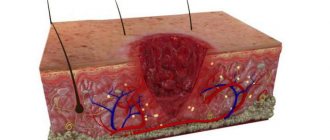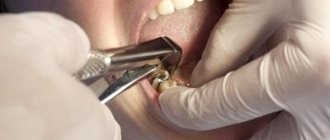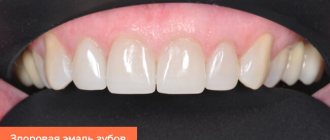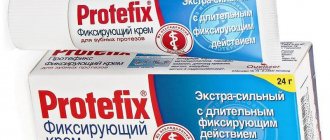Content:
- When do you need to augment your gums?
- Recovery methods
- Correction materials
- Build-up during recession 4.1. In what other cases is flap surgery performed?
- Extension during the period of preparation for prosthetics and installation of implants
- Providing aesthetics for shark and gummy smiles
- Changing the base line of the incisors
- Restoring gum volume after molar tooth extraction
- Features of the postoperative period
Exposed tooth necks, a gummy smile and some other dental problems can be corrected through surgery.
Gingivoplasty is an effective method for improving the aesthetics of the lower third of the face and improving the functionality of the periodontium. Let's look at what gum augmentation is, how it works, in what situations it is used, and what complications may arise after surgery.
Bone regeneration before implantation
Dental implant placement has become a common practice in modern dentistry. But it is not uncommon for a doctor to puzzle a patient with an unexpected proposal to first go through the process of restoring jaw bone tissue. Do not be upset if you are one of those patients who cannot have an implant installed immediately without bone grafting. And in no case should you look for doctors who will agree to follow your impatience and not carry out restoration of the jaw bone tissue - in the end this will end in even bigger problems.
When do you need to augment your gums?
Indications for surgical therapy include:
- anomalies in the structure of the periodontium, frenulum, location of the fangs and incisors;
- congenital disorders of the jaws;
- exposure of roots as a result of inflammatory disease of the oral cavity;
- atrophy of the mucous membranes in the area of individual units, provoked by periodontitis, gingivitis;
- preparation for complex orthopedic treatment;
- restoration of the integrity of the area after mechanical damage, tooth extraction;
- preparation for implantation;
- elimination of mistakes made during previous treatment.
If the root is exposed and the tooth looks unnaturally long, gum augmentation will most likely be necessary. You should not approach the problem purely from the standpoint of aesthetics. It is important to understand that an insufficiently secured canine or incisor can fall out if dental treatment is not carried out in a timely manner.
Is it possible to restore bone tissue in osteoporosis?
Reduced bone density, or osteoporosis, is more common in women, especially postmenopausal and postpartum women, and in people of both sexes with hormonal imbalances. In such cases, you need to consult a therapist and endocrinologist and take prescribed medications. Restoration of bone tissue in osteoporosis is complicated by systemic reasons for its decrease throughout the human skeleton. However, modern technologies and materials used to restore bone during implantation make it possible to successfully implant new artificial teeth, saving patients from wearing removable dentures.
Recovery methods
There are the following options for gum extension:
- Vestibuloplasty . A surgical method for correcting the oral cavity, consisting of redistribution of mucous membranes. It is aimed at deepening the space between the lip and teeth. Helps get rid of multiple gum recessions and exposure of dental roots. It is carried out for speech therapy, cosmetic and orthodontic indications.
- Gingivoplasty . It is used for uneven gingival contours, recession, and pathological periodontal pockets. Helps improve the aesthetics of the lower part of the face and remove an unsightly shark smile. The dentist-surgeon carefully excises excess tissue and transplants it into “deficient” areas. The intervention is considered quite simple.
The specialist decides what type of correction to apply, taking into account the existing diagnosis and the severity of the disorder, the characteristics of the client’s health condition
Correction materials
To compensate for the lack of gingival structures, you need to get material for transplantation from somewhere. This may be the patient's own flap obtained from the soft palate. It is also permissible to use an artificially created barrier membrane or a special collagen matrix.
It is believed that natural “blanks” are a more preferable option. They take root well, which means the likelihood of rejection is minimized, and the recovery period after the intervention is significantly reduced.
Building up during a recession
Many periodontal diseases lead to exposed tooth roots. Then the smile becomes ugly. The coronal part of the units involved in the pathological process appears excessively long. Suitable conditions are created for the active spread of caries.
Unfortunately, it is impossible to close or at least somehow disguise the recession on your own. In such a situation, only a dental surgeon can help. Therefore, you should not waste time studying traditional recipes.
If the disorder is caused by incorrect placement of the frenulum in a child, plastic surgery is indicated. It is performed under local anesthesia. As soon as the normal length of the operated fold is restored, the doctor works with the gum and eliminates its deficiency using a natural/artificial flap graft.
In what other cases is flap surgery performed?
In addition to shortened frenulum and recession, the flap technique is used if:
- the depth of periodontal pockets exceeds five millimeters;
- Gum hypertrophy caused by advanced inflammation was diagnosed;
- moderate/severe periodontal disease was detected;
- teeth are crowded and overlap each other;
- a significant lack of periodontal layers is recorded;
- dental roots are exposed;
- individual units are loose;
- the jaw bones began to collapse, the teeth were weakly held in the sockets.
Returning the original volume to the operated area creates optimal conditions for maintaining oral health and preventing the spread of infection. The doctor administers a local anesthetic and makes an incision in the area of the exposed roots. Removes necrotic accumulations and dead epithelial cells.
Then he takes a flap from the palate and transplants it into the problem area. Suturing the wound. As soon as the regeneration processes are completed, the suture material is removed.
Restoration of bone tissue after implant removal and surgery
Unsuccessful implant installation (the doctor’s choice of a very thin or short implant, its incorrect installation without taking into account the bite) leads to tissue inflammation - peri-implantitis, loosening, breakage or rejection of the implanted tooth. In such cases, the implant fragments are removed from the bone, and then a major reconstruction of the alveolar process is required.
Extension during the period of preparation for prosthetics and installation of implants
Implants are installed after tooth extraction. If a lot of time has passed since the unit was pulled out, the jaw bone will greatly atrophy. Then a problem arises with the implantation of an artificial root - there is simply nothing to fix it in.
But this does not mean that the patient will have to feel complex for the rest of his days because of edentia. The doctor performs bone and gum augmentation. In the lower jaw, this procedure usually requires less effort.
If surgery is contraindicated or the patient refuses implantation, he is offered the installation of a dental bridge. But, if the deficiency of gingival tissue is pronounced, a collagen membrane is still implanted before fixing the structure. It allows you to avoid the accumulation of food debris under artificial crowns.
How is bone volume restored?
To restore the volume of bone tissue in a very thin area at the site of the dental alveolus, bone is split and the cavity is filled with bone tissue (an auto-, allo-, or synthetic graft is used). Then, after bone regeneration is complete, the implant itself can be installed. When it is necessary to increase the height of the bone, simultaneously with the implantation, bone tissue is increased with a special preparation that replaces it. A membrane coating is applied on top. The alveolar bone with various extension designs should heal and strengthen within 4–6 months, after which an artificial tooth (ceramic or metal-ceramic crown) can be installed.
To restore jaw bone tissue, an autogenous graft is used (bone is taken from the patient himself from another part of the jaw); allograft (donor bone is taken from another person) or synthetic materials that mimic bone (they contain calcium and phosphorus).
Providing aesthetics for shark and gummy smiles
Patients do not always decide to undergo dental surgery due to periodontal disease. For most people, it is the appearance of their smile that comes to the fore. If it is gum/shark, don’t worry - you need to seek qualified help from a dental clinic.
The doctor will remove excess periodontal tissue and redistribute it correctly. As a result, the periodontal margin will be freed, and the papillary-marginal structure will begin to fit as tightly as possible. The patient's appearance will improve significantly.
Changing the base line of the incisors
In 70% of cases, people decide to have plastic surgery precisely because of their very exposed upper parts. They are visible even when a person is simply talking, not to mention laughing or openly smiling.
The problem may be congenital or caused by atrophy/hypertrophy of periodontal structures or dental anomalies. The intervention to eliminate the defect is carried out in the surgical office of the dental center. The patient is given local anesthesia, after which treatment immediately begins. Once the intervention is completed, the person can go home.
In order for regeneration to take place without complications, it is necessary to strictly follow medical prescriptions and carefully follow the rules of care for the operated area. Come for scheduled examinations on the appointed days.
You can’t let the disease run!
Do not neglect regular dental examinations, then the problem will be detected at an early stage, which will help solve it faster.
Other publications:
Reviews about bone grafting in dentistry: How much bone tissue is needed for an implant: Preparations for dental bone resorption: What tissues include cartilage and bone tissue: What cells destroy bone tissue:
Features of the postoperative period
In order for the natural/artificial flap to take root as quickly as possible, it is necessary to remember all medical prescriptions. The rules are quite simple:
- do not touch the wound with your hands or foreign objects, do not feel it with your tongue;
- switch to a soft toothbrush, which is less traumatic;
- use a mouth rinse selected by your dentist;
- do not drink alcoholic beverages, do not smoke;
- eat food in a soft (shredded) form;
- do not consume hot or excessively cold foods and drinks;
- reduce physical activity, do not engage in extreme sports;
- avoid hypothermia, dress appropriately for the weather;
- take medications prescribed by the dentist;
- do not visit the bathhouse, sauna;
- Do not take a very hot bath.
If the dental surgeon prescribed antibiotics, they should be used. In this case, the antibacterial course should last exactly as long as the doctor said. These simple rules minimize the likelihood of developing postoperative complications.











